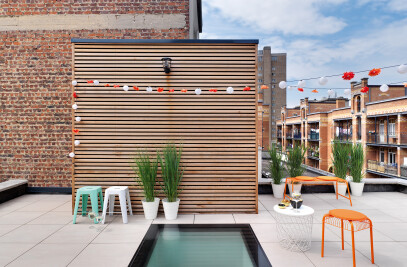It is rare, in Sydney, to design for a site and building located as close to the water as this one. Externally, this building is designed to be calm, refined and discrete. With surroundings like these, ostentatious architecture would merely distract from the stunning views to the harbour.
Due to the steeply sloping site, the apartments at Kurraba Road are barely visible from the street. It is only from the water that the finely detailed roof and facade of the building can be seen. The roof is intentionally kept light and tapered: together with the consistently expressed floor slab edges this creates a dominant language of thin horizontal planes. The rooms between these planes step back to reduce perceived building mass and allow for more privacy for occupants.
From within the building, great importance has been placed on visual connections: each room is orientated towards the water. Living areas have full-height windows protected by a large covered balcony, and the study, secondary bedrooms and bathrooms also enjoy water views. The main bedroom opens completely to the harbour through a juliette balcony, where privacy and light levels are controlled with sliding screens.
To enter the building the main access is from the street; through a car lift that descends to each apartment level. At this entry point the harbour connection is emphasised again: the car lift is open at both ends and acts as a frame or portal through which the water can be seen, even as you sit in your car waiting to descend.

This entry point provides direct access into each apartment, a vital role that contributes to their unique planning configuration. Each whole-floor apartment has three bedrooms, a study and a private garage: an arrangement that is more akin a single detached house than an apartment. Each level is designed to work almost independently from each other: achieving the function and feeling of a private home. To allow each owner to infuse their own personality into the interior spaces a neutral material palette of marble, warm timber, and metallic polyurethane was chosen.
Each room contains a piece of joinery that acts as a focal point within the calm interior spaces. In the bathrooms this element is a marble-wrapped floating vanity, while in the main bedroom a full-height, glossy unit divides the space and doubles as a headboard. The key joinery piece for the kitchen sits under hovering glass shelves: a cantilevered island bench with a multi-faceted, sculptural base.
In these calm interior spaces, clean lines and finely detailed joinery compliment the thin, refined planes that compose the building’s exterior facade. The restrained palette does not compete with but instead adds to the water scenery: glossy and metallic surfaces reflect harbour views from the full-height windows and fill the spaces with light.



































